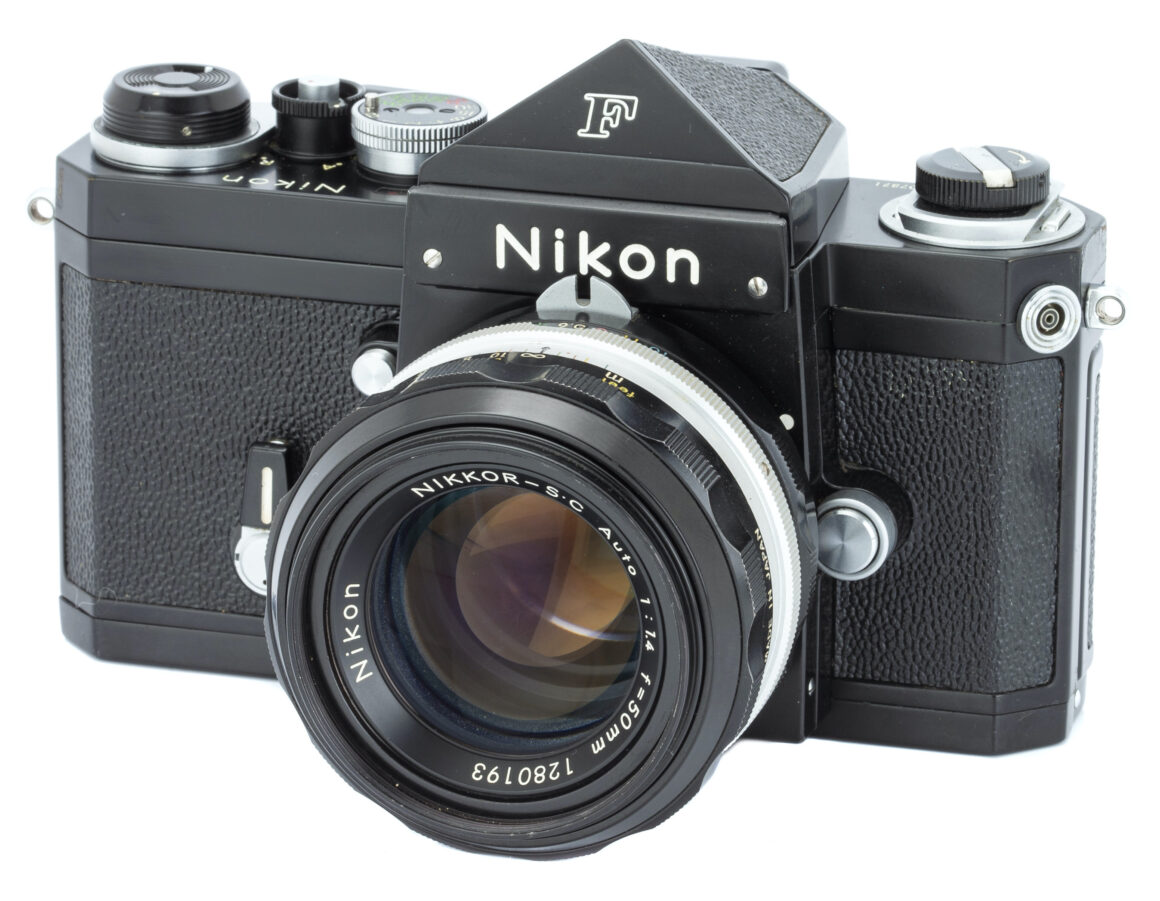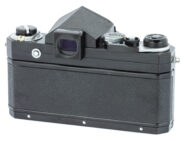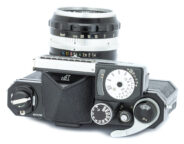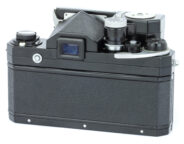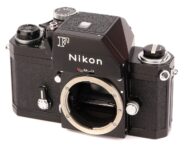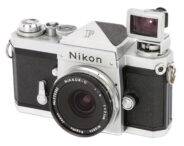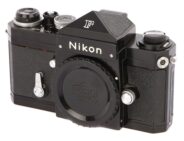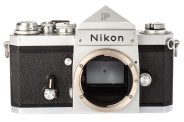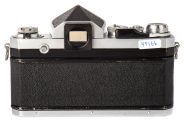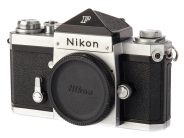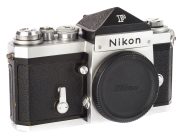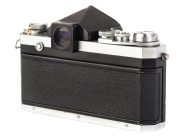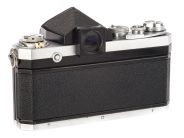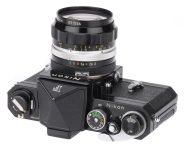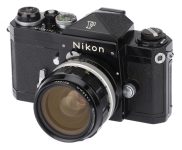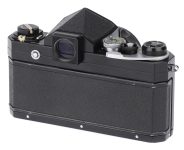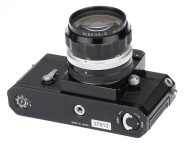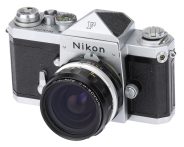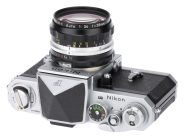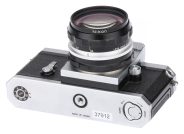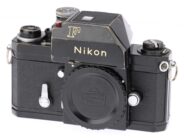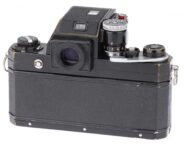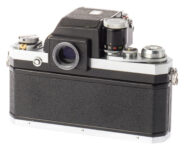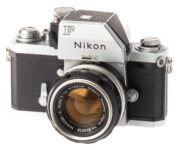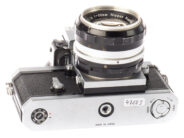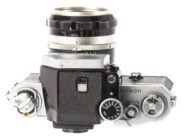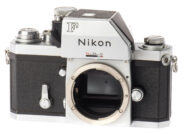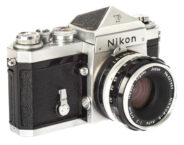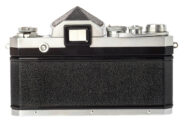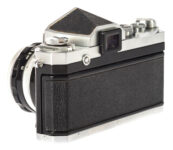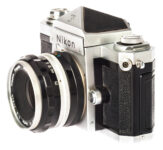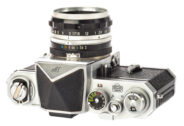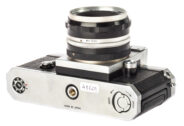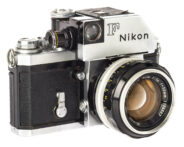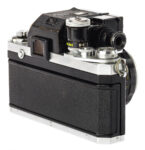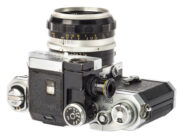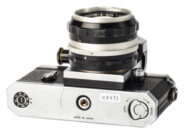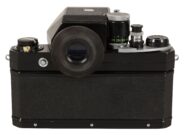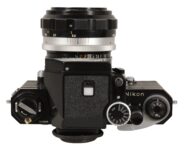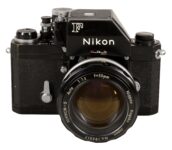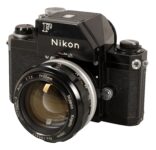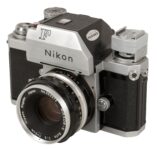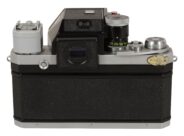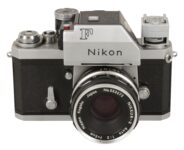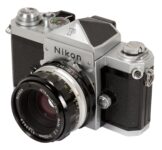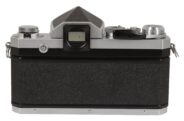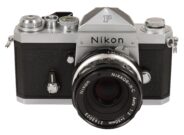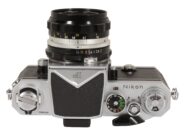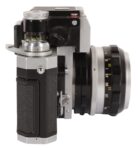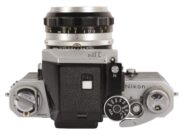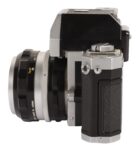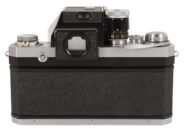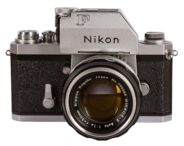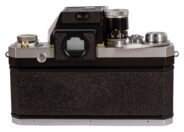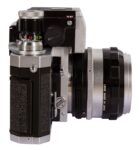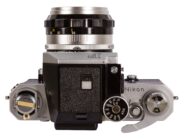Nikon F
35mm MF film SLR camera • Discontinued
- Announced:
- · April 1959
- Production status:
- ● Discontinued
- Country of design:
- · Japan
- System:
- · Nikon F (1959)
Specification
| Format: | |
| 35mm full frame | |
Film type: | 135 cartridge-loaded film |
| Nikon F [46.5mm] | |
| Shutter: | |
Type: | Focal-plane |
Model: | Mechanical |
Speeds: | 1 - 1/1000 + B |
| Exposure: | |
Exposure metering: | None |
Exposure modes: | Manual |
| Physical characteristics: | |
Weight: | 1010g |
Dimensions: | 147x98x101mm |
Manufacturer description #1
ON ALL COUNTS...
the world's finest 35mm reflex - fully automatic
NIKON AUTOMATIC REFLEX
Smoothness, speed, hushed precision - these are the first delightful impressions you have of the new Nikon Automatic Reflex as you put it through its paces. You look through the finder -you see the whole field. The lens is wide open - the image bright, clear. You focus and frame your subject, and shoot. At this point the camera takes over. Except for the hardly perceptible flutter of the mirror and the almost inaudible click of the shutter, you would hardly know the exposure had taken place. The image is still in your finder - bright and clear and sharp as before - the lens wide open, ready for the next picture.
Here are some of the remarkable features of the Nikon Automatic Reflex:
1. INSTANT-RETURN AUTOMATIC MIRROR flips up as you release the shutter, then returns to viewing-focusing position - instantly, automatically.
2. INSTANT-REOPEN AUTOMATIC DIAPHRAGM closes down to 'taking' aperture as you release the shutter, instantly reopens to full aperture, ready for the next picture without further adjustment.
3. INSTANT-ACTION PREVIEW CONTROL permits you to preview depth-of-field at 'taking' aperture or to select 'taking' aperture on the basis of desired depth-of-field. Press the button, and the diaphragm closes down, release it, and the diaphragm instantly reopens to full aperture.
4. AUTO-NIKKOR LENSES assure unsurpassed optical performance - faithful color rendition and superb resolution. Auto-Nikkor lenses with instant-reopen automatic diaphragms are available in 35mm f/2.8, 50mm f/2, 105mm f/2.5 and 135mm f/3.5. When interchanging these lenses on the Automatic Reflex, no attention need be paid as to whether or not the shutter had been wound or the diaphragm pre-set.
5. REMOVABLE EYE-LEVEL PENTA-PRISM VIEWFINDER interchanges with accessory folding hood and magnifier for waist-level focusing and viewing.
6. CONVEX, LENTICULAR FOCUSING SCREEN gives maximum and uniform brightness over the entire field. Has built-in prismatic, split-image rangefinder. Interchanges easily with accessory screens, one with clear spot and cross-hair reticule, and the other with fine-ground spot. Finder field coincides precisely with film area-covers 100% of the image recorded on the film.
7. MIRROR LOCK secures mirror in 'up' position. Permits use of camera with deeply set, extreme wide angles lenses, such as new 21mm Nikkor f4.
8. Single-stroke film transport lever.
9. Non-rotating shutter-speed dial.
10. High-speed rewind crank.
11. Calibrated dual-purpose self-timer.
12. Fully compensated flash synch control.
13. Single terminal for flash-bulbs and speedlights.
14. Completely removable back.
15. Automatic '0' reset exposure counter.
ELECTRIC MOTOR DRIVE - exclusive Nikon accessory permits power driven single exposures... or bursts of 2 or 3 or more, through an entire roll, at the rate of up to 4 exposures per second.
COUPLED EXPOSURE METER - exclusive Nikon accessory couples to both the diaphragm and the shutter. Responds to either setting.
And there are a host of other features and accessories - all of which combine to make this the most advanced reflex '35' of our time.
Manufacturer description #2
check and see how the automatic features of the new
NIKON F AUTOMATIC REFLEX
have been developed to ultimate perfection
1. The automatic features of the Nikon F - Instant-Return Mirror, Instant-Reopen Diaphragm, Instant-Action Preview Control - are internally coupled.
2. The Instant-Return Mirror automatically returns to precise focus position regardless of the angle of the camera - even if held upside down.
3. The Instant-Reopen Diaphragm automatically stops down and instantly reopens without disturbing or moving the diaphragm setting - even if that setting is between aperture markings.
4. The Auto-Nikkor lenses for the Nikon F Automatic Reflex may be interchanged at any time. And the automatic diaphragms remain fully operative whether they are interchanged before or after the shutter is wound.
5. The Instant-Reopen Preview Control for observing depth-of-field does not have to be re-set manually. Press the button, and the diaphragm automatically closes down to 'taking' aperture. Release the button, and the diaphragm reopens instantly - automatically.
6. The Instant-Action Preview Control is entirely independent of the shutter release mechanism. When using the Preview Control it is impossible to cause an accidental exposure.
7. The automatic action of the mirror and diaphragm is so incredibly fast, it is virtually imperceptible in the finder. Even with the camera and accessory Electric Motor Drive - shooting at the rate of 3 exposures per second, there is still a continuous, bright image constantly visible in the finder. The image never blacks out; never dims.
The qualities we have enumerated are especially revealing of the maker's intense devotion to perfection. You will discover many more qualities in the New Nikon F Automatic Reflex, each equally deserving of your admiration, and each further demonstrating that the Nikon F is the finest automatic reflex you can own.
Manufacturer description #3
the new, incomparable...
NIKON AUTOMATIC REFLEX
...with instant-return automatic mirror, instant-reopen automatic diaphragm, and instant-action preview control
Nikon quality has a special significance wherever 35mm cameras are used or discussed. The most knowledgeable, the most critical users of 35mm equipment have come to respect the Nikon name beyond all others. The new Nikon Automatic Reflex shares in this heritage of excellence - standing head-and-shoulders above any other single-lens reflex - in demonstrable features, performance and quality.
From the moment you first hold the new Nikon Automatic Reflex to your eye its quality becomes apparent. The image is full-size, bright and clear. Focusing is fast, easy, positive. You frame your subject, you shoot. Except for the almost inaudible 'click' of the shutter nothing seems to have happened. The image is still visible in the finder, bright and clear as before.
In the instant of exposure, the lens diaphragm closed down to the pre-selected 'taking' aperture - the mirror flipped up - the shutter flashed across the film plane. Then, instantly, automatically, the mirror returned to viewing position and the diaphragm reopened to full aperture.
The result of this unique Nikon design is a speed and ease of handling not usually associated with single-lens reflex cameras. This will come as no surprise to 35mm enthusiasts, to whom Nikon speed and ease of handling is a firmly established tradition.
The Nikon quality inherent in this new camera makes itself felt in many ways... in the exclusive depth-of-field Preview Control that stops the lens down to 'taking' aperture at a touch of your finger, and lets the diaphragm spring open again when your finger is removed. It is reflected in the fresnel-type interchangeable focusing screen that gives you an unmatched brightness of field, and in the built-in split-image rangefinder that serves as a further aid to focusing.
It is apparent in the way the mirror locks up and out of the way to accommodate very deep-set lenses, and in the removable eye-level roof-prism which interchanges with an accessory waist-level finder. It is reflected in the precise alignment of lens, mirror and roof-prism - what the finder 'sees' is exactly what registers on the film. But most of all, Nikon quality makes itself felt in the way all of these features combine to provide you with a superb photographic instrument.
Incomparable Nikkor Lenses are standard equipment for the Nikon Automatic Reflex. They are available in focal lengths ranging from 21mm f/4 extreme wide-angle through 1000m f/6.3 super-telephoto. Four of these lenses, 35mm f/2.8, 50mm f/2, 105mm f/2.5 and 135mm f/3.5 are designated Auto-Nikkors, and are equipped with instant-reopen automatic diaphragms. All lenses above 180mm can be adapted to fit both the Nikon Automatic Reflex and the Nikon SP.
Manufacturer description #4
There are many reasons why the Nikon F is the fastest selling big ticket 35mm camera, today.
Its remarkably brilliant finder and its extraordinary ease of handling by themselves distinguish the Nikon from other fine 35mm reflex cameras.
But in addition, the Nikon F offers more automatic features, more design innovations, more lenses - all Nikkors (ranging from 8mm super wide angle through 1000mm super tele-photo), and a wider range of unique accessories, than any other camera. For example, the Dealer can sell the Nikon F with the remarkable new Photomic Finder (Nikon F Photomic) which incorporates a meter and prism finder in the same housing, or he can sell the Nikon F with the conventional prism finder, and have the opportunity to sell the Photomic finder, or the conventional meter, afterwards.
The performance and durability of the Nikon F have been proved under the most demanding conditions 'man shoots' and satellite launchings, while attached to speed boats, racing cars and planes, in extremes of heat and cold. It has withstood the incredible demands of continuous motor operation - a performance matched by no other 35mm camera.
Today the Nikon F is the '35' used by more Professional, Scientific and Industrial photographers than any other camera. And it presents the Dealer with more opportunities for profitable lens and accessory sales.
NIKON "F" AUTOMATIC REFLEX CAMERA - 35mm; 36 exposure, 1 x 1 1/2 Available with interchangeable Photomic finder (Nikon F Photomic) - combining a meter and prism finder in one housing - or a conventional pentaprism eyelevel finder. Features instant return automatic mirror and instant reopen automatic diaphragm; built-in depth of field preview control; built-in ground glass rangefinder - interchangeable with standard ground glass. Provision for locking mirror up; accepts diaphragm and shutter coupled exposure meter; electric motor drive. Accepts accessory waist level finder; 13 shutter speeds, click-stop, from 1 to 1/1000 plus T & B, on single non-rotating dial; full synch plus electronic flash at 1/60; auto zero reset exposure counter; calibrated, delayed action self timer; removable back; fixed take up spool; single stroke rapid film advance; high speed film rewind; tripod socket built into camera body.
INTERCHANGEABLE FINDERS AND FOCUSING SCREENS
Eye-level photomic finder (meter and prism in one housing) provides full size image of the entire field even when wearing glasses. Interchanges with pentaprism finder or with accessory waist-level hood and magnifier. Finder field coincides precisely with film area - covers 100% of the image as it will record on the film.
Convex, lenticular focusing ground glass gives maximum and uniform brightness over the entire field. Has built-in prismatic, split-image rangefinder as a further aid to precise focusing. Interchanges easily with other types of Nikon ground glasses.
INSTANT- RETURN AUTOMATIC MIRROR
Whisper-quiet, lightning fast-the mirror returns to precise focusing-viewing position the instant the exposure is made, even with the camera held upside down. A special, patented brake helps eliminate vibration from the mirror's action.
INSTANT-REOPEN AUTOMATIC DIAPHRAGM
Focus and view with the lens wide open. At the instant of exposure, the diaphragm automatically closes down to 'taking' aperture. Then, instantly, automatically it reopens again to full aperture. So unique is the design of the Nikon automatic diaphragm that even when pre-set for intermediate openings-between markings - the action of the diaphragm will not disturb the setting. When interchanging lenses, no attention need be paid as to whether or not the shutter had been previously wound. The diaphragm is fully automatic and foolproof.
INSTANT-ACTION PREVIEW CONTROL
Press the Preview Control button, and the diaphragm stops down. Permits you to see the depth-of-field at 'taking' aperture - or to select 'taking' aperture on the basis of desired depth-of-field. Release the button, and the diaphragm reopens instantly. The Preview Control is independent of the shutter release mechanism, and cannot cause accidental exposure.
Manufacturer description #5
- 35mm single lens reflex camera.
- Picture size: 24mmx36mm.
- Interchangeable Eye-Level finder with penta-prism supplied as standard equipment.
- Interchangeable type A focusing screen supplied as standard fitment. Vibration-free, automatic instant return mirror which can be placed in locked up position.
- Focal plane shutter using ball bearing and titanium foil curtain.
- Built-in calibrated self-timer.
- Flash synchronization for all speeds up to 1/1000 sec., with provisions for electronic flash up to 1/60 sec.
- Press button type depth of field preview control.
- Instant reopening automatic diaphragm, closes to preselected "taking" aperture at instant of exposure: automatically reopens to full aperture.
- Bayonet lens mount.
- Self-resetting type exposure counter. Film winding by single stroke lever which also cocks the shutter and operates the exposure counter.
- Rapid film rewinding crank which folds down when not in use.
- Detachable camera back which is interchangeable with Motor Drive Back.
- Fixed take-up spool.
- Tripod socket in body casting
- Accepts Model 3 Nikon exposure meter
- ASA ratings from 6 to 4,000.
Nikon F Photomic-T
With exception of the following, all other specifications remain exactly the same as in Nikon F.
- Interchangeable Photomic-T finder supplied as standard equipment.
- Film speeds range from ASA 25 to 6,400.
- Dimensions: 147mm x 103mm x 101mm with 50mm f/1.4 lens.
- Weight: body without lens 830 g (1.8 lbs.), body with 50mm f/1.4 lens 1,155 g (2.5 lbs.).
Manufacturer description #6
The Nikon F is a 35 mm single lens reflex precision camera. It inherits numerous proven features of the Nikon S-series rangefinder model, and also incorporates abundant outstanding mechanisms and advantages which have been originated and developed for the most advanced single lens reflex. These unique features and functions originated by Nikon include:
Inherited from Nikon S-series rangefinder model:
- Crank-type film rewinding lever.
- Film advance lever enabling winding in a single sweep or several short strokes.
- Titanium foil shutter curtain.
- Shutter mechanism utilizing ball bearing and steel friction balls.
- Color-coded flash synchronization system.
- Synchronization terminal accepting cordless flash.
- Regular camera back that is interchangeable with Motor Drive back.
Specially originated for Nikon F:
- Interchangeable through-the-Iens meter/finder system.
- Depth of field preview control.
- Mirror lock-up.
- Interchangeable viewfinders and focusing screens.
- Exposure meter coupled to both shutter speed and diaphragm aperture through the meter coupling prong.
- Color-coded depth of field scale on Nikkor lenses.
The camera body is composed of 918 pieces. These parts are precisely designed, processed, finished and assembled and are subject to strict inspections to bring out the matchless performance of the Nikon F camera.
Manufacturer description #7
The new Photomic T brings 'thru-the-Nikkor' exposure control to the Nikon F, and provides the user with another logical choice of interchangeable finder systems.
'Thru-the-Nikkor' exposure control goes far beyond the idea of just another thru-the-lens meter system. By linking the performance of the Nikkor lenses with the performance of the new Photomic T, it brings as much assurance of picture quality as of exposure accuracy.
Affixed to the Nikon F, the Photomic T measures subject brightness directly from the viewing screen. It employs two CdS cells, located in the prism housing. They 'see' only the framed-in picture area on the screen.
Each cell is equipped with a 2-lens optical system which excludes light rays coming from any angle outside the picture area. Furthermore, the finder prism is 'black' coated to eliminate surface reflections. Every precaution has been taken to prevent extraneous light from reaching these cells and upsetting the accuracy of the readings.
The Photomic T is cross-coupled to the shutter and aperture rings, but its operation does not interfere with automatic diaphragm action. The lens remains wide open for viewing and focusing at all times. It only stops down when the shutter is released, and then instantly reopens. The meter needle is visible in the finder and in the meter window on the Photomic T housing.
Nikon F camera bodies now in use require some modification to permit interchanging present finders with the Photomic T.
Manufacturer description #8
2 thru the-lens meter systems:
* full-screen * narrow-angle
Such is the versatility of the Nikon F that it provides not one, but two interchangeable thru-the-lens meter systems: the Photomic T for full-area measurements and the new Photomic TN for narrow-angle readings.
The Photomic T measures the brightness of the entire scene as it appears on the viewing screen. Its angle of acceptance is the same as the lens in use.
The new Photomic TN permits selective brightness measurements of small areas of the scene, as represented by the image in the 12mm diameter center spot found on most Nikon F viewing screens. This acceptance angle is less than 1/3 that of the lens: about 13° with the 50mm lens; about 4° with 200mm tele, etc.
Both Photomic systems are cross-coupled for full-aperture operation, thus retaining all the advantages of automatic diaphragm lenses. Both also permit stop-down or shooting-aperture readings, where desired. And both handle film speeds from ASA 25 to 6400.
The meter needle, in each case, is visible in the finder as well as in the window on the prism housing. Both are identical in appearance, except for the battery test button on the Photomic TN. Initially, the Photomic TN will be supplied with Nikon F cameras only. It will be available separately later, for use on all cameras that accept the Photomic T.
Photomic T or Photomic TN, the choice is yours with the Nikon F. Or, you can use both interchangeably. You switch meters - not cameras. Isn't this what versatility is all about?
Manufacturer description #9
In 1965, the Photomic T brought thru-the-lens exposure control to the Nikon F. It was a unique system. It could be used with any Nikon, and it interchanged with all finders. It permitted wide-open readings with auto-diaphragm Nikkors as well as stop-down readings with non-automatic lenses, or when using extension tubes, bellows, etc.
Like most other meters, it averaged scene brightness. But while averaging meters are reliable in normal situations, they tend to introduce incorrect readings with backlighted scenes, or where subjects are contrasted against brilliant backgrounds. Something had to be done.
Nikon ruled out the spot method (used by some manufacturers) because selection of the target area to be measured is extremely critical. Choosing the wrong area will invariably produce incorrect exposure.
The idea of a built-in choice of spot or average readings would only add operating complications, without eliminating the objections. And this would be unacceptable in a camera which had gained much of its reputation for speed and ease of handling.
Early in 1967, Nikon introduced the Photomic TN, the self-compensating center-weighted system. While it measured the brightness of the entire screen, more than 60% of its response sensitivity was concentrated in the central subject area.
It was a totally new approach. And its practical ability to deal even with difficult light conditions became immediately evident The rest is history.
The new Photomic FTN is the next logical development. It makes full use of the center-weighted principle, the facility for wide-open and stop-down measurements, and all the other earlier features. In addition, it offers: automatic ASA/lens-aperture indexing, which eliminates the need to reset the film speed when interchanging lenses; extended film speed range (ASA 6 to 6400); intermediate settings to compensate for transmission differences in certain special viewfinder screens; visible shutter-speed setting in finder; 2-second and 4-second exposure readings where required; and "on/off" meter switch which also functions as battery test button. Another FTN innovation is the pincer-type clamp which secures it snugly to the camera body.
Initially, the Photomic FTN head will be supplied with cameras only. Its availability as an interchangeable accessory is anticipated early in 1969. The FTN was designed for use with any Nikon F. However, cameras bearing serial numbers below 6900001 will require some adaptation.
From the Nikon Journal (Vol. 6 No. 4, June 30, 1989)
First displayed to the American public at the June 1959 convention of the Master Photo Dealers & Finishers Association in Philadelphia, the Nikon F was one of several new 35mm single-lens reflex designs introduced that year by Japanese manufacturers. Although 35mm professional photography was dominated by the rangefinders throughout the 1950s', these new SLRs - particularly the Nikon F - sparked a definite trend away from RFs toward reflexes, which have prevailed to this day. One only has to consider some of the now familiar features of the Nikon F that no other reflex had at the time to realize how truly modern the Nikon F must have appeared in 1959. Back then the F was the first and only reflex to offer such exclusive features as mirror lockup, depth of field previewer, completely automatic re-opening lens diaphragm, provision for motor, dual coupled metering, 100% exact field coverage: in short, features that since have been maintained in each of the F's successors up to and including the new F4, and which are now taken for granted as standard offerings in any professional 35mm SLR!
For a short while after its premier, Nippon Kogaku's new professional SLR was known simply as the "Nikon Fully Automatic Reflex" without any reference to the "F", even though the first production models clearly had the script F engraved on their prisms! However, the now famous letter was soon officially added in advertisements and brochures. Most likely the "F" stands for "Flex". Since the other "big four" camera manufacturers around this time added the term "flex" when naming their first SLRs (e.g., Canonflex, Contaflex), it is natural to think that Nippon Kogaku could have called their new reflex the "Nikonflex", but instead chose to abbreviate it to Nikon F.
During the decade of the fifties even the most advanced of precision crafted SLRs were slow & cumbersome to use, suffering from image "blackout" in those having simple nonreturning mirrors, and image "dimout" in models equipped with preset or semi-automatic lenses. All of these limitations inherent in earlier SLR designs were at once overcome in the new Nikon F which is why it can truly be called a "fully automatic" reflex. Many of the key innovations which contribute to its automatic functioning are to be found in the central mirror chamber: the instant return mirror with positive action independent of gravity, so that the mirror returns with the camera held in any position; the depth of field previewer, which acts instantaneously and reversibly, and is entirely independent of the shutter release; and the internally coupled mechanism for automatically reopening the lens diaphragm immediately after exposure. Nikon Inc. did a superb job of pointing out these superior advantages found exclusively in the F over similar features in rival SLRs of the period. Another important reason for designing the F to be fully automatic was so the engineers at Nippon Kogaku could readily integrate into the F motorized SLR photography. This is possible since, immediately after the shutter is released, the F is primed for the next shot without requiring any further presetting adjustments. Apart from this action packed automatic mirror mechanism and the eyelevel prism assembly, the rest of the F is virtually identical to the SP/S3/S4 series in appearance, mechanics, quality and ruggedness. Despite these similarities, however, few accessories are actually interchangeable between the RF and reflex systems due to the F's larger dimensions and different lens mount.
The first production camera is numbered 6400001!
The finish on the early production Nikon Fs is of the highest quality. These early bodies are actually better constructed than the later production in some small, but noticeable ways. For instance, in all 1959 versions, the wind lever pushes in flush with no extra play whatsoever; the removable back fits on absolutely snugly; and the camera seems to rattle less when given a light shake. All numbered dials are engraved, giving optimum visibility in poor lighting. Some of these dials found on later Fs are anodized, which can be considered a technological advance, but they are actually harder to read in dim light.
In keeping with Nippon Kogaku's principle of modular construction & maximum versatility, the Nikon F was designed to offer complete interchangeability of viewfinders and focusing screens. While Fs normally were equipped with the eyelevel prism & split-image fresnel focusing screen "A", in 1959 these could be replaced with the waistlevel hood, and screens "B" (fresnel lens w/central clear spot, identical to "A" except the central beam splitter is missing) and "C" (plain ground glass w/central cross hairs). In the early focusing screens, the frames were finished in shiny black enamel with the lettering painted in white. Later production screens had a dull nonreflective black finish with the lettering painted in various colors, usually white, red or yellow. The first version prism is equipped with a square eye-piece, and carries the engraving "Nippon Kogaku Japan" underneath the prism roof. Early waistlevel finders have flat tops with the triangle logo engraved in a central circle. Bought separately from the camera, these finders came fitted with a black plastic finder cap in a brown leather case complete with a green velveteen optician's cloth! Black plastic rectangular dioptor attachments from -5.0 to +3.0 strengths were available in 1959. Since the square eyepiece on the early prism is not equipped with threads as is found on later versions, the first type of dioptor was secured instead by sliding it over the eye-piece frame.
Nippon Kogaku built into the F a large and solidly secured bayonet mount which has remained basically unchanged to this day in all of the F's successors. This F mount was originally designed to accommodate an exclusive set of four lenses with fully automatic diaphragms, designated "Auto Nikkors". Premiering with the F in June of 1959, these lenses were the Auto Nikkor-S 3.5cm/2.8; Auto Nikkor-S 5cm/2; Auto Nikkor-P 10.5cm/2.5; and Auto Nikkor-Q 13.5cm/3.5. The two telephotos are essentially the same design as their RF counterparts, whereas the 3.5cm wide-angle lens was of a special retrofocus design (reverse telephoto) in order to provide enough clearance for the mirror to swing up unimpeded by the rear lens element. In addition to the automatic diaphragm, which is spring controlled by a small pin next to the rear element, the original four Auto Nikkors were fitted with an aperture coupling prong designed to mate with the Model I clip-on exposure meter. This now ubiquitous half-moon shaped attachment can be found on most Auto Nikkors up to the newest AIS variety, thereby making the latest Nikkors compatible with the earliest F bodies! This method of aperture coupling is unique to the F series, and is the single most important feature that allowed owners of the F during the 1960s to constantly acquire the latest in light metering technology simply by adding the current Photomic prism.
The first versions of the Auto Nikkors carry the following distinguishing markings similar to those found on the contemporary RF Nikkors. First, the lenses are calibrated in "cm" focal lengths; second, the infrared focusing point is designated with a red "R"; third, the focusing scale is marked in feet only; finally, both the focusing and aperture numbers are marked with small "ticks" to precisely indicate the position of each setting. Those owning more recent Auto Nikkors will note by comparison that many of these small markings are missing from subsequent versions produced as early as 1960!
The original set of Nikkors for the F was standardized to accommodate 52mm screw-in filters and series VII accessories. The proper lens cap for these early Nikkors is the black plastic snap-on type with the triangle logo. Shades for the reflex Nikkors are individually marked & engraved like the RF variety with the triangle logo & "Nippon Kogaku Japan". An additionally stenciled in "F" marks the shade as being the reflex version. Shades for the 2.1cm & 3.5cm lenses are of the screw-in type, while those for the normal & telephoto Auto Nikkors snap onto the filter mount. Owners of the 1959 Nikon F weren't limited to using only the Auto Nikkors. By attaching the N-F adapter tube one could mount onto the F any of the earlier RF Nikkor telephotos from 18cm and up that were originally designed for use on the RF reflex housing!
Last but not least is the final major accessory that premiered with the F in June of 1959: the exclusive reflex version of the famous Nikon Electric Motor Drive, the F36. This motor is basically identical in concept & design to the rangefinder S36 unit, but being powered by 12 volts, it is a bit faster with speeds of up to 4 frames per second possible with the mirror locked up. In addition, the F36 was equipped with an extra dial giving the user the option of varying the framing speeds. Like the RF motor, early F36 units were powered via a one meter cord by a grey vinyl external battery pack holding, in this case, eight "C" type batteries. Like the one made for the S36 9 volt power pack, a voltmeter of similar design, but reading up to 12 volts , was made available as part of the F36 outfit in 1959.
From the Nikon Journal (Vol. 20 No. 3, June 30, 2003)
STANDARD EYELEVEL FINDER
This finder was offered with the first Nikon F, #6400001, released in March of 1959, and was produced throughout the F era up to camera #7451052 in May 1974. Many professionals preferred the standard finder even after the metered finders were developed. These days, a standard finder is usually worth more than a metered finder in the same condition. Part of the reason is that most older meters no longer work, and a sleek, compact standard finder may be more desirable than a metered finder that is inoperative. Some Nikon enthusiasts prefer the look of an F body with a standard finder than the bulky metered version.
PHOTOMIC F 'FLAG SWITCH' FINDER
This is the first metered finder for the Nikon F. It was introduced in March 1962, with approximate body #6450001. It is sometimes referred to as a "Type I" Photomic Finder. The light measurement was made at a window on the front of the finder. This is probably the rarest F finder since fewer than 25,000 were manufactured.
PHOTOMIC F BUTTON SWITCR FINDER
This was the second metered finder for the Nikon F. it was introduced in October, 1963, about 6 months before the 100,000th Nikon F came off the assembly line. It was offered with approximate body serial #6470000, and is sometimes referred to as a "Type II" Photomic F Finder. Like the Type I flag switch finder, light measurement was made at a window on the front exterior of the unit. The only external difference between the Type I & II finders is the battery switch.
PHOTOMIC 'T' FINDER
This was the first 'through-the-lens' (TTL) metering finder for the Nikon F. It was introduced in September, 1965, with approximate body serial #6580000. The 'T' finder did not fit bodies manufactured prior to this time, and Nikon had to change the body slightly to accommodate it. Bodies that were modified were so indicated by a 'red dot' placed in front of the serial number on the left top plate. In at least one case, a new red dot body was sold by an authorized Nikon dealer with an earlier Photomic F button switch finder.
With the introduction of this finder, the eyepiece was changed from rectangular to circular. Just prior to the end of 'T' finder production, around body #6780000, the triangular logo on the top plate of the F bodies was changed to simply 'Nikon '. Black bodies with the older logo have been seen that have higher serial numbers than chrome bodies with only 'Nikon'.
Bodies with red dots continued to be manufactured from at least body #6575857 through the short lived 6600000 series that used only about 2,500 numbers before the 6700000 series was begun (presumably to prevent overlapping with rangefinder bodies?). This means that at least 22,500 plus red dot F bodies could be around. It is not known at this time if 'non red dot' bodies were produced anywhere within this 22,500 serial number sequence. The outcome of this situation is that bodies with red dots have become collectible because of their rarity. More rare are the 2,500 or so F bodies in the 6600000 series.
PHOTOMIC 'TN' FINDER
This was the second TTL metering finder for the Nikon F, identified by a white 'N' next to the battery switch on top. It had center-weighted metering. The 'TN' was introduced in April, 1967 along with body serial #6800000 and they were supplied with bodies up to about #6900000.
PHOTOMIC 'FTn' FINDER
This was the third, and final, TTL metering finder for the F. Introduced in September, 1968 (along with body #6900000) with an improved TTL center-weighted meter, and a better method of indexing the lens aperture to the meter. Instead of setting the disk on top of the shutter speed selector to the largest f-stop of the lens, as was done with the 'T' & 'TN' meters, you simply rotated the f-stop ring on the lens from minimum to maximum back to minimum (sometimes called the 'Nikon Shuffle'). This finder had the highest production run of any finder and was made until the end of F production in May, 1974.
From the editor
The following versions of the Nikon F were offered:
- Nikon F (1959) - a standard model with conventional pentaprism eye-level finder;
- Nikon F Photomic (1962) - as F, but with interchangeable Photomic eye-level finder, combining a window meter and prism finder in one housing;
- Nikon F Photomic T (1965) - as F, but with interchangeable Photomic-T eye-level finder with built-in TTL exposure meter;
- Nikon F Photomic TN (1967) - as F, but with interchangeable Photomic-TN eye-level finder with built-in TTL exposure meter and center-weighted metering;
- Nikon F Photomic FTN (1968) - as F, but with interchangeable Photomic-FTN eye-level finder with built-in TTL exposure meter and center-weighted metering. Shutter speeds displayed in the finder.
***
The weight and dimensions are indicated for the camera body with the Nikkor-S Auto 50mm F/1.4 lens mounted.
Similar cameras (6)
| Model | Shutter | Metering | Modes | Year |
|---|---|---|---|---|
| Kiev-17 akaКиев-17 |
M, 1/1000 | -- | M | 1978 ● |
| Kiev-19 akaКиев-19 |
M, 1/500 | TTL · WA | M | 1985 ● |
| Kiev-19M akaКиев-19М |
M, 1/500 | TTL · OA | M | 1988 ● |
| Kiev-20 akaКиев-20 |
M, 1/1000 | TTL · OA | M | 1983 ● |
| Nikkorex F akaNikkor J |
M, 1/1000 | -- | M | 1962 ● |
| Ricoh Singlex | M, 1/1000 | -- | M | 1962 ● |
